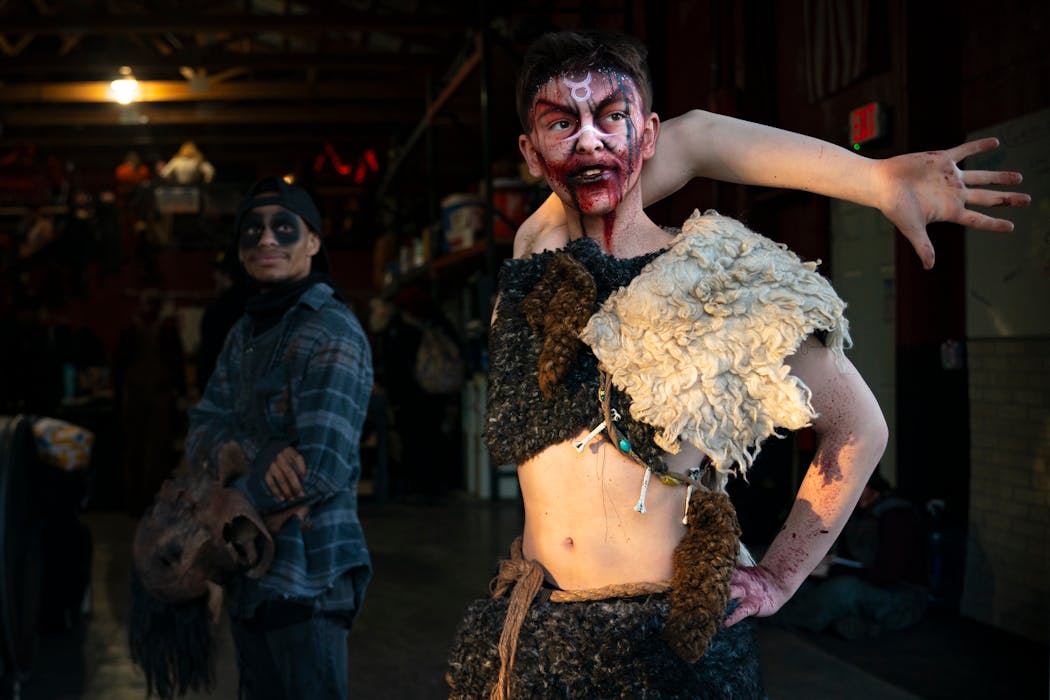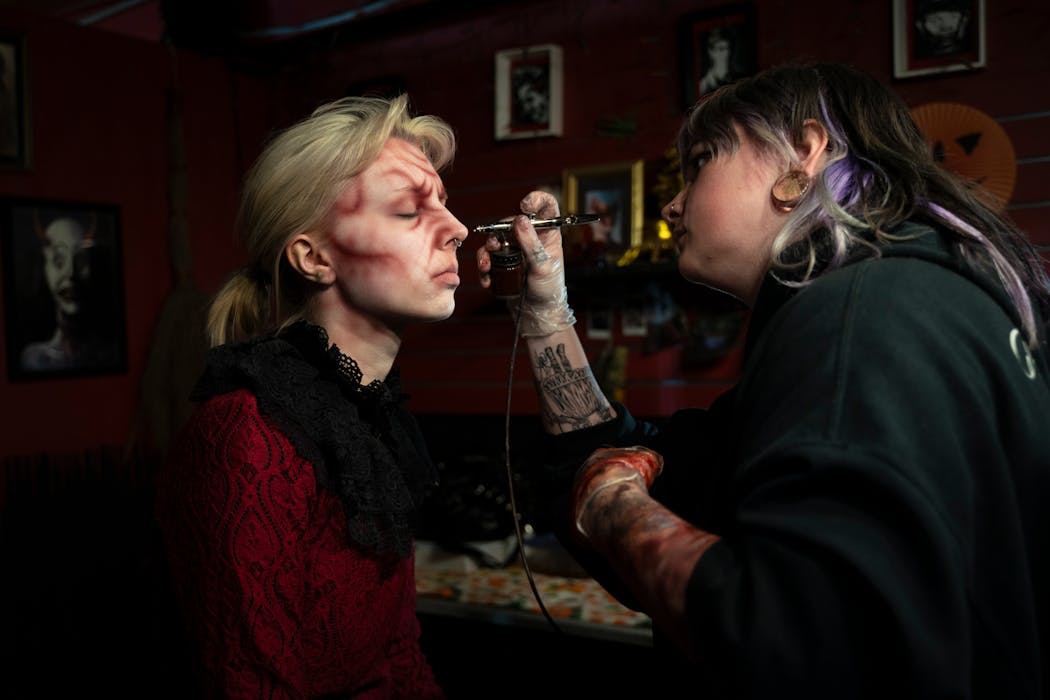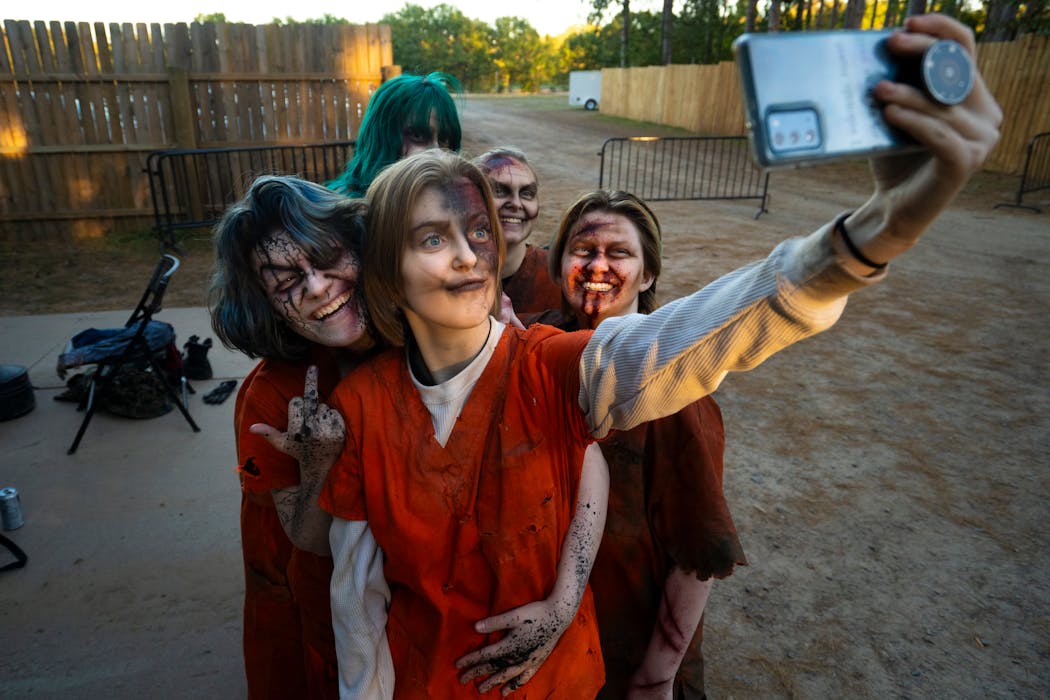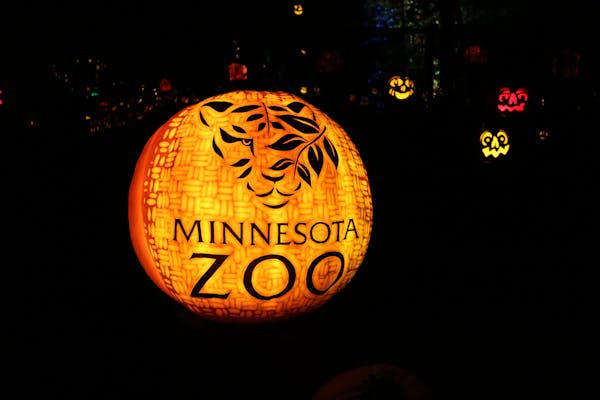As sundown approaches at Pinehaven Farm near Wyoming, Minn., one of the barns is stuffed with cowboys and scarecrows. Butchers and sheriffs. Prisoners and aliens. But because their stage is the sprawling, woodsy acreage of Dead End Hayride, these so-called "scare actors" play a blood-soaked, walking-dead version of the above — a soldier bears a large gunshot wound, a pasty-white monk looks like he just crawled from a crypt.
The scene resembles an enormous Halloween bash, with professional-caliber costumes. Upstairs, in the makeup booths, artists airbrush on fake blood (some of it mint-flavored!). Despite their realistic-looking bruises and gashes, the actors don't seem so scary as they down Monster-brand energy drinks to fuel themselves for the long night ahead.
Once dusk descends and a cowbell signals the call for "places," a crazed-looking clown snuffs out a cigarette and an undead nun hits the porta potty. As soon as the sky turns black, all of these eerie characters become hauntingly real.
Some 200 scare actors are the telltale heart of Dead End Hayride, which has grown from a modest family-run operation into one of Minnesota's largest haunted attractions, welcoming 5,000 guests on a sold-out Saturday night.
Their job is to startle and spook, moan and groan, make creepy conversation, and deftly react to the occasional visitor whose fight-or-flight response causes them to lash out, freeze or panic.
The goal is not to traumatize people, said Dead End's owner Jeremy Hastings, who sold his sports car to start the attraction on his family's farm over a decade ago in his early 20s. He hopes visitors are entranced by the spectacle — and dosed with a hearty adrenaline rush.
"We're not trying to be the scariest, most horrific haunted house," Hastings explained. "Our goal is that our customers are walking to the parking lot kind of looking over their shoulder, but laughing about the experience."
Scare tactics
What should newbies do to steel themselves against Dead End's frights? A group of return guests offers advice as they wait in the hayride line. Pretend you're not scared. ("They sense fear.") Close your eyes. Or, you can run — but you might get chased. Last year they raced through the cornfield tailed by a guy with a chainsaw.
The hayride sets off through a dark woods to a Wild West ghost town. Suddenly, a massive fireball explodes, radiating heat for extra realism. In the early years, one of Dead End's sets was little more than a chain-link fence accessorized with garbage bags and strobe lights. Today, there's a sprawling maze of scenes that suggest a Hollywood back lot: a multi-room prison; a mirrored funhouse; a seedy motel with dismembered dolls hanging from the ceiling.
Staff members built this season's new vampire castle scene from foam blocks coated in concrete. Each year, Dead End might spend six figures on props. Some are animatronic creatures created for movies. Other oddities are found on Facebook Marketplace, including the Vietnam War-era helicopter in the military encampment and a sunken ship slated to carry a zombie fishing crew.
Each set is elaborate — rows of skulls lining the crypt were hand-cast; the graveyard contains real headstones, rejected for typos — and enhanced with eerie lighting and fog machines. But it's the actors who bring the scenes to life.
By day, they are personal-care assistants, parents, HVAC technicians, even the branch president of a credit union. By night, they're united in their love of putting on a spooky show.
"They form this kind of ragtag family of unique individuals who all really, really enjoy Halloween," Hastings explained.
Horrifying roles
The hayride pulls into an old sawmill, complete with circular blades roaring. Out of nowhere, a tattooed millworker in stained overalls leaps out, revving his chainsaw (it's real, but with a protective cover). Riders scream and duck.
Chainsaw guy is actually Byron Brown, a mechanic from St. Paul, whose skin is still splattered with grease from a car he worked on earlier. He figured it fit with his look, which suggests he's taken a sawmill blade to his face.
Some actors like to repeatedly scare the same visitor. Or eavesdrop on conversations to creepily address guests by name. Brown's favorite scare tactic is the bait-and-switch: One actor distracts the guests while he leaps onto the wagon. "All of a sudden, you're right there and 'boom,' they jump out of their seats!" he said.
After passengers are dropped off outside the prison, they go on a long walk through one scene after another. Some scares unfold slowly, such as the tension-building tiptoe through the aisle of a prison-yard bus, where shadowy figures slump in the seats. Others are literal shockers, including an electric chair execution gone awry.
In the salvage yard, a bloodied mechanic with black eyeballs (costume contact lenses) steps out from the shadow of a junked car. It's Oliver Bauer, a high school thespian from Vadnais Heights playing a role very different from the one he holds in his school production of "Clue."
Bauer likes to bang on oil drums, or crouch under a wreck and grab ankles, or follow guests and trail his fingers up their back while growling and hissing. Unlike many haunted attractions, Dead End allows its actors to touch guests (with limits). It helps break the "fourth wall" and makes guests feel like they're actually in a horror movie instead of just watching it.
"We have people who drop to the floor," Bauer said. "We have people who cry. We have people who pee themselves, and they announce it to everyone, like, 'Omigod, I just peed myself.' "
Symbiotic scaring
As acting gigs go, Dead End is no Guthrie. Roles pay about $15 an hour, can stretch into the wee hours and include acting in the rain and mud.
"Sometimes it's not glamorous," Hastings admits. "It's an incredibly physical job. You lose your voice."
Yet each year, a majority of the staff comes back, in part due to the camaraderie Dead End cultivates. (There are post-show meals and pre-season parties.) Sometimes even the owner joins right in the fun. Last season, Hastings spent a night hiding in the show, deploying his signature "jumpscare" (exactly what it sounds like). "I haven't laughed and been so entertained all year," he recalled.
Scaring, Hastings said, is a symbiotic relationship: The scare-ers get as much thrill as the scare-ees. "The customer gets an adrenaline rush from your scaring them, as those brain chemicals get their heart pumping. But as a scare actor, you get that rush, too."

Helen Simonson is in Jane Austen mode with 'The Hazelbourne Ladies Motorcycle and Flying Club'






